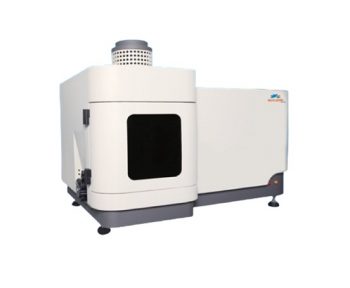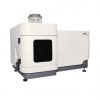Vertical TorcH Dual-View InDuctively CoupleD Plasma Optical Emission Spectrometer
Sensitive, precise, stable, swift, and convenient in perfect harmony…
As the long-awaited flagship product of acculab Instrument, the ICP30000 series has finally emerged, fulfilling the expectations of many after years of anticipation. With a sleek and practical design featuring a vertical torch for dual view, seamless switching between radial and axial modes at the touch of a button, and a novel combustion chamber airflow design coupled with a sealed ventilation system, the accumulated heat dissipates imperceptibly.
Its patented three-dimensional distributed constant temperature system, equipped with multi-point temperature monitoring, effortlessly achieves long-term thermal equilibrium.
Additionally, the compact and optimized RF generation system, integrated control system with multiple control boards merged into one for higher integration, comprehensive integration of independently developed high-precision mass flow controllers, and more intelligent, user-friendly, and streamlined analysis software, ensure that your analytical work is carried out with ease and proficiency
Super fast Testing Speed
Rapid testing velocity endowed with intelligent integration.
Bidirectional observation
Robust bidirectional observation functionality.
Research-grade Detector
High-performance large-format research-grade detector.
Qualitative Analysis
Unique qualitative analysis methodology.
Wavelength Calibration
Practical wavelength calibration functionality.
Software Analysis
Powerful software analysis features.
Performance Advantages:
Rapid testing velocity endowed with intelligent integration
Full spectrum analysis can be completed in a single exposure, eliminating the need for multiple exposure optimizations while still achieving excellent detection limits and linear dynamic range. Analysis of all elements can be completed within 15 seconds of a single exposure. Each analysis spectral line can be optimized for measurement by setting arbitrary suitable integration periods within the exposure time. All spectral line intensities can be read out in a single exposure to expedite analysis speed, or individual spectral lines can be specified for independent readout with a reading time not exceeding
2 milliseconds.
Precision and stable spectrophotometer system
The precision and stability of the spectrophotometric system have been achieved through special temperature control and heat dissipation treatments along the axial forward illumination path, ensuring precise temperature stability of the entire optical path and minimizing thermal drift of spectral lines. The entire intermediate optical system features no moving parts and is well insulated from the combustion chamber, with all optical components sealed within a constant temperature chamber maintained at 35°C. This meticulous and stable temperature control (±/0.1°C), along with multi-point temperature control, ensures minimal detection limits and outstanding long-term stability.
Blow-scan type optical chamber
For wavelength measurements below 189nm, the option to use either argon or nitrogen gas for purging the optical path is available. This signify cantly reduces air absorption in the ultraviolet range, thereby enhancing the detection capability of ultraviolet spectral lines. Normal testing does not require purging of the chamber. However, when measuring deep ultraviolet spectral lines, purging gas flow can be controlled via software.
The purging gas flow rate in the normal mode is set at 2.0 L/min, while in the fast mode, it is increased to 4.0 L/min.
Robust bidirectional observation functionality:
The utilization of intelligent positioning vertical torch dual-view technology, in conjunction with an intermediate step grating-prism cross-dispersion optical structure, enables measurement over a broad wavelength range without sacrificing light flux or sensitivity.
The optical mirror positions automatically initialize upon startup, allowing for seamless one-click switching between radial and axial modes without the need for cumbersome optical adjustments. This effortlessly meets the requirements for precise qualitative and quantitative measurements.
High-performance large-format research-grade detector
The imported large-format research-grade Charge Injection Device (CID) detector features
a million-pixel resolution, boasting the largest target surface size and single pixel area among similar products. With an effective detection area of 28mm × 28mm, it allows for the addition of spectral line measurements as needed. Each pixel is equipped with anti-saturation overflow protection, effectively eliminating issues related to spectral line saturation overflow.
This ensures that spectral lines of varying intensities can be measured and analyzed within a single exposure.
Stable and reliable solid-state RF power supply
The instrument features a solid-state generator operating at 27.12MHz, with water cooling, automatic tuning, and built-in protections against overload and overheating. Operating at
a fixed frequency provided by an external crystal oscillator, the excitation frequency remains stable and unaffected by internal oscillations. With advantages including small size, high efficiency, stable output power, and various protective features, the generator incorporates fully automatic matching technology to further enhance instrument stability and safety.
Highly adaptable sample introduction system
The standard configuration includes a Scott nebulizer, glass concentric nebulizer, and integrated torch. Additionally, various other types of nebulizers, nebulizer chambers, and torches are available as options,
such as cyclonic nebulizer chambers, high-salt resistance nebulizers, and HF-resistant nebulizers. Various sizes of central channel in the torch are also available for selection. Equipped with a four-channel peristaltic pump, the speed is continuously and automatically adjustable, controlled entirely by the computer. It features a quick-pump function and stable, pulse-free sample introduction.
Combustion chamber with a completely new air duct design
The combustion chamber features a new airflow design in combination with a patented torch extension sleeve, to mitigate the impact of heat accumulation on the optical path and nebulizer chamber, thereby effectively enhancing the long-term stability of the instrument.
Combustion chamber diagram
The new main control board integrates the matching box interface board, power interface board, and main control board into one, with high integration effectively enhancing
anti-interference capability, reducing the number of circuit boards, and bringing advantages to later maintenance and production costs. All external interfaces are changed to Ethernet ports, facilitating wiring and improving signal anti-interference capability. Integrated bus-type RS485 module facilitates communication with other bus-type peripherals and is compatible with newly developed flow meter devices. All new architecture components can communicate with the main control chip via RS485 bus for data transmission, thereby interacting with the host computer.
High-precision mass flow controller
The independently developed mass flow controller features a high-performance proportional valve combined with a high-precision flow sensor and equipped with intelligent algorithms to better adapt to the pneumaticic characteristics of instruments. It complies with the highest accuracylevel (0.5) of the general technical standard for mass flow controllers (SJ/T 10583-2016), offering lower repeatability (0.5% F.S) and shorter response time (achieving the set flow rate within 0.85 seconds). It supports digital signal control, intelligent online software adjustment, and boasts strong
anti-interference capabilities, resulting in lower errors.
Unique qualitative analysis methodology
The truly comprehensive qualitative analysis gathers a vast amount of spectral information and interference controls. Tailored for complex matrices, it effectively distinguishes between major and trace elements while identifying potential interfering elements, thereby minimizing misinterpretation. The operation is simple and expedient, requiring no preparation of standard solutions. Merely dissolve a portion of the sample, initiate spectral information collection with a single click, and complete data compilation, retrieval, comparison, and evaluation with another click. Instantaneously, probabilistic qualitative results are provided, ensuring accuracy and speed.
Intelligent nitrogen monitoring function and multiple purge modes
This feature enables timed nitrogen purging and alerts for nitrogen supply, effectively reducing the occurrence of ACID damage due to insufficient nitrogen purging time. Multiple purging modes are available, including the cold cone purging mode, which effectively cuts off the plasma tail, reduces element self-absorption effects, and enhances plasma torch stability. Both normal and fast purging modes of the chamber can be used for testing deep ultraviolet elemental spectral lines. Rapidly converting the entire chamber into an inert gas atmosphere greatly reduces air absorption of UV short waves, thus enhancing the sensitivity and detection capability of deep ultraviolet elemental spectral lines.
Practical wavelength calibration functionality
Carbon emission spectral lines are utilized for preliminary wavelength calibration. After each ignition during startup, the software automatically calculates the optical offset.
Based on the magnitude of the offset, the software decides whether optical initialization calibration is required, eliminating the need for preheating and consumables associated with mercury or neon lamp calibration. Furthermore, the software features built-in functions for calibrating characteristic spectral line positions and spectral peak positions. Users can perform peak calibration for single or multiple elements using standard solutions at any time, ensuring the accuracy of analytical wavelength measurements.
Powerful Software Analysis Features
The software features a wizard-style interface, which is intuitively designed,
user-friendly, and allows users to easily understand functions at a glance, making your testing work seamlessly. With practical functions such as automatic torch alignment, one-click ignition, and safety state monitoring, as well as a vast spectral line library, users can freely select and add secondary sensitive lines for different elements. The software also includes professional optical path debugging functions, qualitative, semi-quantitative, and quantitative analysis capabilities, instrument diagnostic optimization functions, flexible
full-spectrum research capableities, powerful offline processing functions, and method- multiple sample result set management functions. Additionally, it incorporates scientifically intelligent background correction and interference removal algorithms, enhancing the professionalism and accuracy of testing.
Using the Application of ICP 30000 in the Lithium Battery Industry as an Example:
Abstract: Lithium cobaltate (LiCoO2) and lithium nickel cobalt manganese oxide (LiNiCoMnO2) were dissolved in aqua regia on an electric hotplate. Twenty metal elements including iron, nickel, copper, titanium, and lanthanum were simultaneously determined by a dual view inductively coupled plasma emission spectrometer (ICP30000). The method achieved a lithium cobaltate recovery rate of 86.5% to 108.5% and a lithium nickel cobalt manganese oxide recovery rate of 88.0% to 109.5%. The linear correlation coefficient was greater than 0.999. The relative standard deviation for lithium cobaltate was between 0.31% and 1.79%, and for lithium nickel cobalt manganese oxide, it was between 0.39% and 2.29%. The method is simple to operate, fast in analysis, highly sensitive, and suitable for the detection requirements of positive electrode materials in the lithium battery industry.






Reviews
There are no reviews yet.